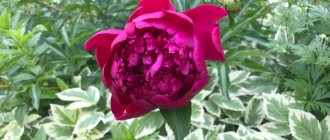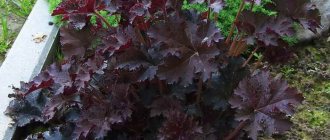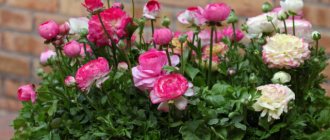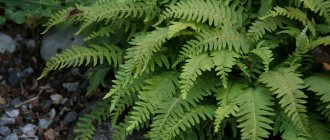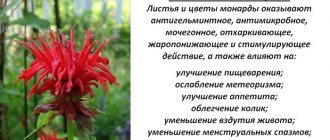If you are looking for a plant that would add a touch of exotic variegation and sophisticated grace to the appearance of the garden , meet the canna flower. Growing this guest from overseas countries on our sites has long ceased to be a curiosity, and today many amateur gardeners and professional breeders have developed a sincere sympathy for cannes. Well, the time has come for us to find out how to properly grow flowers and what is needed for this.
Canna - an exotic decoration for your garden
Cannes varieties
Asian. The common ancestor of all modern Canna species is the South Asian Canna. It was given the name garden canna, due to the domestic types bred as a result of the long-term work of breeders. As a result of the selection, three hybrids were bred.
Canna Crosi is a plant that looks like a gladioli. The species is distinguished by its short stature, its average length is 100 cm. The flower petals have a beautiful purple or dark shade of green with a white coating.
The initial Crozy hybrid was obtained back in 1868 and after that, many varieties were formed. The best of them: Livadia, America and President.
Main types
Today, about 50 types of crops and more than 1000 varieties are known. There are also quite a lot of classifications: varieties and species may differ in stem height, color of leaves, buds, flowering period and other characteristics. We will consider the most popular species and varieties grown in garden plots and in apartments.
Canna garden
This name is given not to an individual plant, but to a group of various large- and small-flowered garden hybrids that are widely used in floriculture. The following varieties are especially popular:
- "America" with purple flowers with a diameter of 12 cm, blooming in mid-summer; - "President" - has large inflorescences up to 30 cm long, grows no more than 1 m; - "Sunny Beauty" - with dense green foliage and yellow-cream luxurious flowers. Its height reaches 1 m; - "Clara Buisson" - has beautiful orange flowers with speckled petals and purple leaves.
You can also often find representatives of the “German Titov” variety in garden plots, distinguished by their purple-green leaves and pink flowers. The culture is capable of bearing fruit.
Indian canna
This culture is native to western India, although it is also widespread in central and south America. The plant is quite tall - adult representatives reach two meters in height. The leaves are light green, sometimes with a red stripe. The flowers have pink and red shades, collected in brushes. This type of canna is characterized by a long flowering period, which begins in June and continues until late autumn.
Eland drooping
Its natural habitat is considered to be swamps and shallow waters of sea coasts. The species grows especially well in soils saturated with humus. It belongs to evergreen plants and reaches a height of 1.2 m. Its leaves are quite large - about 12 cm wide and up to 60 cm long. In comparison, the flowers are much smaller and have a yellow-gray tint. The species is quite often used for indoor landscaping, and is also planted around swimming pools.
Kanna low
This type of canna has elongated half-meter oval leaves of a bright green color. Red-orange flowers, up to 10 cm in diameter, are collected in neat inflorescences.
Canna Wyoming
A very original variety, the peculiarity of which is the preservation of decorative bronze foliage throughout the season. Wyoming canna has stems up to 1.5 m tall with bright orange flowers. The length of the inflorescences is 10–12 cm, flowering is quite long and abundant.
Canna Confetti
The variety is medium in size, but can boast of the beauty of its yellow-cream flowers with brownish and red spots. This original variegated appearance of the buds fully explains the name of the culture.
Kanna Richard Wallace
The plant can grow up to 1 m. It is highly valued by flower growers and landscape designers for its attractive yellow flowers with red splashes and strokes, seemingly randomly scattered across the entire surface of the petals. The length of the inflorescences reaches 25 cm. The flowering period occurs at the beginning of July.
Orchid Cannes
They are considered a tall class, their length varies from 0.5 to 2 meters. Large leaves have wavy edges. Leaves are light green or purple in color. Some varieties should be highlighted:
- Andenken an Pfitzer of orange and purple succulent inflorescences, blooms from mid-summer
- Sueveya are lemon-colored, low flowers (up to a meter), bloom from mid-June
- Richard Wallace flowers are characterized by red dots with a yellowish tint
Rowan
A familiar tree, familiar to everyone since childhood, the mountain ash (Sorbus) is widely used in urban landscaping, and may seem banal to many. However, there are a huge number of types and varieties of rowan, which are not only distinguished by the varied colors of the berries, but also by their sweetish taste (sweet-fruited varieties). Garden rowan can also be dwarf or weeping. And some types of rowan are distinguished by unusual foliage - thinner openwork or, on the contrary, solid leaf blades.
Among the fruit and ornamental varieties, one can distinguish rowan "Titania", "Pomegranate" and "Dessert" with very rich dark red fruits of a sweetish taste. Rowan "Burka", also a sweet-fruited variety, is distinguished by dark purple (almost black) berries. And the most unusual of rowan trees are amazing trees, whose fruits are painted snow-white. These include Kene and Kashmir rowan.
Rowan berries serve as a valuable food for birds. Thanks to the increased demand for birds, some trees may become bare by January, so be sure to enjoy this enchanting feast for the eyes in the first half of winter.
- Size of an adult plant: from 1.5 to 12 meters, depending on the type and variety.
- Exposure: sun, light partial shade.
- Fruit color: red, orange, yellow, pink, burgundy, dark purple, white
Rowan (Sorbus). jlcummins
Deciduous Cannes
The tallest Canna plants reach a height of 3 meters. They have very picturesque leaves of various shades, but the flowers are small, only 6 cm.
The most popular Durban variety is a flower with yellow and orange hues and beautiful leaves that will be a real gem in any garden. Choose a plant to your liking, and numerous photos of Canna on the Internet will help you make the right choice.
Description and features of the flower
In appearance, canna is a combination of banana and orchid or gladiolus flowers. It’s hard to take your eyes off its blossoms, it’s so interesting and delightful. The plant was first discovered in the tropical forests of India, South America, China and Indonesia. These countries began cultivating this species back in the 17th century. The culture came to Russia thanks to Portuguese merchant ships.
This is an upright tall natural creature, reaching a height of 2.5-3 meters. The trunk tends upward, but does not grow in breadth. The trunk is surrounded by massive wide leaves, which can reach up to 70-80 cm in length and not exceed 30 cm in width. The leaves are elongated, conical in shape with elongated strong veins, of a rich green hue.
Canna is beautiful in any period, without buds, just with spreading leaves, and with magnificent inflorescences.
Thanks to the massive stem, the bush grows strong and does not require additional support. The buds bloom in lush armfuls of asymmetrical inflorescences. Each flower can vary in size from 10 cm to 25 cm. The most common color of the buds is red. This is the main tone of the culture, but now breeders have done a lot of work and have developed a variety of colors from speckled yellow to orange or crimson. Sometimes you can see a white color. The root system of cannas does not have a tuber - the roots branch in different directions, which allows them to hold the powerful trunk in an upright position.
The main features of the culture are:
- The breed practically does not get sick.
- After wintering, it quickly grows and gains strength.
- Does not require special care or cultivation.
- Under favorable conditions, it can bloom almost until the first cold weather.
However, the disadvantage of the plant is that it does not adapt to sub-zero temperatures and can freeze during frosts. Therefore, it is recommended to dig it up for the winter. Another drawback in cannas is that in the vastness of our Motherland they have no smell, although in nature they have a rich aroma.
Growing in the garden
Before planting canna, the seeds must be prepared. Due to their hard shell, it is imperative to soften them first. It is better to do this in a thermos with warm water for no more than 4 hours. You can simply put it on a hot battery for 10 hours.
The seed planting season is in January and February. The ground temperature is about 23 degrees, the terrain should be loosened. After 4 weeks, the first shoots appear, and as soon as 4-5 leaves sprout, transplant the greens into separate pots.
Most of them will not bloom until next year. Germination must take place at a temperature of at least 20 degrees. For healthy growth, water the plant once a quarter with a solution of potassium permanganate.
When choosing a good place to plant Canna, consider the following features of the flower:
- the plant loves sunny places without drafts
- fertile soil rich in organic matter (humus, sand, peat and leaf soil)
- good drainage is the key to the health of your plant
Transfer
Young plants are planted in open ground in the second half of May - early June, when night frosts no longer appear. The cannas should be positioned so that the gap between them is 50-80 cm.
When planting young cannas in open ground, maintain the required distance between them (50-80 cm)
Advice! Since cannas thrive in loose, nutritious and well-cultivated soil, we recommend making a so-called “warm bedding” for them. It is a hole (W30*D30*D70 cm) filled with horse manure, the layer of which should be less than 20 cm. Well-loose soil (at least 25 cm) is poured on top of the manure.
Follow all the rules for planting these plants and the result will definitely delight you.
Canna garden care
After planting and the beginning of flowering, Cannes need to constantly care for the flowers. When the greatest activity occurs, it is necessary to fertilize the plant three times with minerals and constantly plow the soil. Constant but moderate watering of the plants until the first shoots emerge.
When the plant blooms, it is necessary to water it more, but the main thing here is not to overdo it, excessive moisture can lead to the death of the plant.
To get rid of insects, use insecticides. Dry branches must be cut off in a timely manner and weeds removed. At the end of the growing season, it is necessary to thoroughly loosen the soil to protect the roots from freezing.
Diseases and pests
Although cannas have the peculiarity of not getting sick in most cases, some types of pests still stand in the way of beautiful flowering:
- Earthworms - Nematodes. They infect the roots of the flower, forming peculiar growths on them, with the help of which they suck out the juices from the crop. The environment for their reproduction is summer heat and high soil moisture, as well as a large amount of fertilizers. The fight is carried out with chemicals - Chloropicrin, Carbon disulfide.
- Slugs are snails that feed on young greenery. The soil around is either mulched or treated with fungicides.
- Aphids - adhere to the leaf from the underside, suck nutrients from it, contribute to color loss and drying. Cleaning of aphids is carried out using a soap solution.
- Scale insect - it burrows into the leaves at the base and feeds on internal juices. The drug Vertimek is used in the fight.
- Spider mite - located on the underside of the leaf, tangles it, sucks out all the juices, thereby ruining the greens. For destruction, the Mavrik control agent is used.
For the healthy growth of a flower, you just need to monitor its condition and prevent the appearance of new harmful inhabitants.
Canna after flowering
If you notice that your flower has stopped blooming, it means it needs rest and watering should be significantly reduced. Cut off all the leaves at the top and place the branch itself in a cool place, with a temperature of 10-12 degrees.
In the spring, dig up the rhizome and replant the plant, after dividing the plots. If you do not have an insulated balcony, then this would be an ideal option for canna. You can leave the pot at home or transplant it into the garden.
After flowering, garden cannas must be hilled high to protect the roots from freezing. Watering should be reduced and gradually stopped completely. Immediately after frost, the leaves must be cut off at a height, otherwise the plant may rot.
Triumph of Gatsania hybrid
So September has arrived - a month that manages to combine both summer and autumn, which is why in Rus' it has long been called the summer guide. It can be different: warm and cold, sunny and rainy. The sun is still warming, but the morning dew has already touched the delicate leaves and flowers with its cold breath. Despite this, hybrid gatsania continues its triumph in flower beds.
Hybrid Gazania (Gazaniaxhybrida) is a very spectacular perennial plant of complex hybrid origin, often grown as an annual. Its height is only 20-40 cm. The leaves are basal, rosette, dark green or grayish-green, very variable in shape, woolly underneath. Inflorescences-baskets with a diameter of 7-10 cm, simple, double, semi-double. Reed (marginal) flowers are white, cream, yellow, orange, pink, crimson, red, red-brown, bronze, purple, at the base with spots of brown, black and white; tubular - purple-black. Varieties of hybrid Gatsania have a longer flowering period (from late June - early July until frost) than just species of this genus. Gatsaniya is grown both in a mixture of colors and in single-color varieties.
Gatsania hybrid is cold-resistant: it can withstand temperatures down to -5-7°C; it is light-loving and extremely drought-resistant. However, in hot, dry summers, lack of watering reduces the intensity of its flowering. It is not demanding on soils, but it develops and blooms better on loose, fertile soils. Resistant to diseases and pests. It is propagated by seeds, which are sown for seedlings in late March - early April. Shoots appear after 5-7 days, then (after 7-10) they are pruned (the terminal parts of the taproot of a young seedling are removed in order to stimulate branching of the root system). Next, fertilize with complete mineral fertilizer. Hardened seedlings are planted in a permanent place at the end of May.
Gatsania is good in mixborders (flower beds) in the foreground, low borders, flower beds, ridges, groups; It is spectacular in rock gardens among stones.
https://glav-dacha.ru/izyskannye-sorta-gazanii/https://rostok.info/sad-i-ogorod/cvety-i-rasteniya/gazaniya.htmlhttps://7dach.ru/Uleyskaya/triumf- gacanii-gibridnoy-2911.html
Canna in winter
By mid-autumn, you need to carefully dig the plant out of the ground and transplant it to where it will be stored during the cold season. It is recommended to choose a slightly warm room with moderate humidity and dim lighting.
Rhizomes are stored together with sawdust and sand, you can also add peat. The air temperature should be 7-8 degrees. Inspect the rhizomes at least once a week to check for rot. Immediately remove the damaged part to a healthy stem.
Butterflies: beautiful creatures from the world of insectsHow to grow excellent petunia seedlings
- How to properly water an orchid in a pot: the benefits of automatic watering for the plant
Strong changes in temperature can negatively affect the health of the plant, keep this in mind. As a last resort, Cannes can be left in the refrigerator until the end of winter. The tubers are washed, dried and placed in a vegetable storage compartment, checking for rot. Some are stored in a jar or in a bucket on the loggia, and with the onset of severe cold, they place the bucket next to the balcony door.
It can also be stored in the ground, but in compliance with the temperature regime. The soil must be moistened 3 times a month. If winters are mild, you can store Cannes directly on the site in a place protected from water and wind. Just cover the tubers with a large layer of sawdust.
Derain
One of the most popular garden shrubs, which is widely used in landscape design and has gained the love of gardeners. Particularly popular are the numerous variegated forms of the tree, which may have a creamy white or yellow border, as well as contrasting light veins. Varieties with white markings on the leaves turn pink in the fall.
Blood red dogwood (Cornus sanguinea). Lyudmila Svetlitskaya
But the brightest purple-red color is acquired by those varieties that were inconspicuous all summer, due to the green color of the leaf blade. Also, the bush often bears snow-white berries, effectively contrasting with the dark crimson foliage.
The new variety of blood red tree "Compressa" (Cornus sanguinea 'Compressa') can be called a compromise between these two types. Being green-leaved, this variety remains decorative in the summer, thanks to its very unusual textured wrinkled leaves, which also turn a bright crimson color in the fall.
Derain is a very unpretentious plant, about which they say “planted and forgotten,” but the shrub still requires watering during the dry period.
Combination with flowers
Cannes goes well with:
|
|
|
|
|
|
|
|



